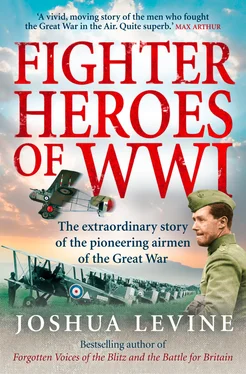Ronald Sykes remembers the feeling of a spin:
It was the most sickening sensation. You were thrown violently to one side of the cockpit with a fierce blast of wind on one cheek. You had to switch off the engine and straighten everything – the control stick and the rudder. You usually didn’t come out of the spin quickly. You just had to put everything central and wait. Eventually you entered a nosedive and you pulled the stick back slightly and you were all right.
Smith-Barry argued that, in order for pupils to be able to practise manoeuvres such as these, the training schools needed a standard type of dual-training machine that was capable of performing them. In December 1916, he was placed in charge of the Gosport School of Flying. The aircraft that he chose as his advanced trainer was the Avro 504K. Frank Burslem encountered great difficulty flying an Avro:
I was a very slow pupil. I suppose I was a little bit dense. I took eight hours to go solo whereas the average was about three hours. My problem was psychological. I went up in an Avro and was put into a spin by the instructor. He told me what to do and how to get out of the spin but when I saw the world turning round on an axis directly below me, I absolutely froze on the controls and I couldn’t do anything. I was so fascinated watching the ground, getting lower and lower, that I couldn’t do anything at all. The instructor was swearing and cursing and he overcame the pressure I was putting on the controls and he got us out of the spin about 500 feet off the ground. The instructors thought I wasn’t fit to fly the faster machines – the single-seater fighters – so I was sent to fly heavier machines – two-seaters.
Smith-Barry’s teaching methods prepared pupils for the realities of combat flying. They also allowed slower pupils – like Burslem – to learn their limits before it was too late. For the pilots such as James Gascoyne who relished the possibilities that flying offered, the sky was the limit:
A loop comprises racing your engine, opening your engine full out, putting it into a slight dive to get full speed, then all you do is pull back the joystick, right back into your stomach, and the machine goes up, over, and then drops. As it drops, you switch off the engine and come smoothly out into a glide. They are usually done at a height of a thousand feet or more to give you time to recover in case you lose too much engine speed and the machine comes straight down.
Ronald Sykes remembers the thrill of the vertical bank:
It was the most delightful manoeuvre. You could just move your stick an inch or two over to the side and she would immediately turn over onto a wingtip. At the same time, you pulled the stick back into your stomach and the nose began to whip round the horizon. You also had to put on full left rudder because the engine tended to make the nose climb into the sky on a left turn and the left rudder kept it down.
Pilots took pleasure in trying to outdo each other and achieve what had not been achieved before. Frederick Powell came up with an idea that was very nearly his last:
One night I was lying in bed and I thought, ‘I’ll do something nobody else has ever done – tomorrow morning I will loop off the ground!’ My Bristol Bullet had a maximum speed of about seventy miles an hour but I thought that if I held it down just over the top of the grass until I was going flat out, then I could go up in a very big loop and when I got to the top I could pull the joystick into my tummy, whip the tail over and gravity plus the engine would pull me round. So next morning, I went off and tried it. I pulled up in the loop, flipped it – and realized I hadn’t enough room. I have a feeling that my life was saved by some sheep grazing at the far end of the airfield. They all started to run out star fashion away from me and I was so interested in watching them that I didn’t stiffen myself up. I went straight into the ground at about 150 mph. I shot through the front of the aircraft, my belt broke, I hit my head on the instrument board and was knocked out. My legs shot through the rotary engine. Another quarter of a turn and I would have lost both my legs. As it was, I finished with the engine in my crotch. The ground was hard and nothing had sunk more than a few inches into the earth. Everything was flattened like a pancake. My CO stopped everyone from running out because he thought I was going to be a nasty mess. So he strolled slowly across to the crash. When he got there, he found me singing. I was quite out of it but I was singing the latest song:
Sprinkle me with kisses,
A lot of lovely kisses,
If you want my love to grow …
While practising something new in his Sopwith Camel, Graham Donald cheated death in a manner that might make a believer of the sternest atheist:
As I was approaching the airfield at 6000 feet, I decided to try a new manoeuvre which might prove useful in combat. It was to be a half loop and then I would roll at the top and fly off in the opposite direction. I pulled her up into a neat half loop but I was going rather slowly and I was hanging upside down in the air. With an efficient safety belt that would have been no trouble at all – but our standard belts were a hundred per cent unsafe. Mine stretched a little and suddenly I dived clean through it and fell out of the cockpit. There was nothing between me and the ground. The first 2000 feet passed very quickly and terra firma looked damnably ‘firma’. As I fell, I began to hear my faithful little Camel somewhere nearby. Suddenly I fell back onto her. I was able to grip onto her top plane and that saved me from slithering straight through the propeller which was glistening beautifully in the evening sunshine. She was now diving noisily at about 140 mph. I was hanging onto her with my left hand and with one foot hooked into the cockpit, I managed to reach down with my other hand and I pulled the control stick backwards to pull her gently out of her dive. This was a mistake – she immediately went into the most appalling inverted spin. Even with two hands on the top plane, I was slipping. I had about 2500 feet left. Remembering that everything was inverted, I managed to put my right foot on the control stick and I pushed it forwards. The Camel stopped spinning in half a turn and went into a smooth glide but upside down. It was now easy to reach my hand down (or up) and pull her gently down and round into a normal glide. I grabbed the seat cushion which was obstructing the cockpit, chucked it over the side and sat back down. I was now at about 800 feet but in spite of the extraordinary battering she had received, my little Camel was flying perfectly. One or two of the wings were a bit loose but nothing was broken. I turned the engine off in case of strains so my approach was made in silence. I made an unusually good landing but there was no one there to applaud – every man-jack of the squadron had mysteriously disappeared. After a minute or so, heads began to appear all over the place – popping up like bunny rabbits from every hole. Apparently, when I had pressed my foot on the control stick, I’d also pressed both triggers and the entire airfield had been sprinkled with bullets. Very wisely, the ground crew dived as one man for the nearest ditch.
As well as learning how to fall back into an aircraft from a height of several thousand feet, pilots had to learn to make cross-country flights. Charles Chabot remembers a particularly popular method of navigation:
One wasn’t particularly instructed in the use of a compass and our map-reading technique was not very good. When we had to get from A to B, most of us used to fly by ‘Bradshaw’. That was the name of the railway guide. One simply followed the railway lines. It was the recognized way of getting about.
A pilot who ‘Bradshawed’ his way down to a seaside resort, like Archibald Yuille, might have an enjoyable day out:
Читать дальше












